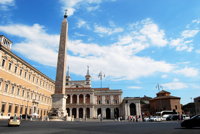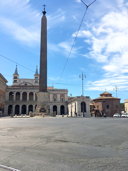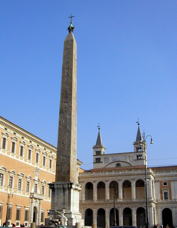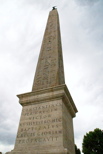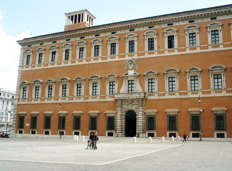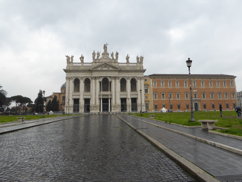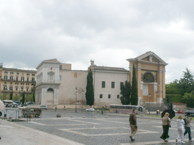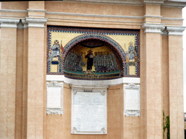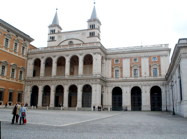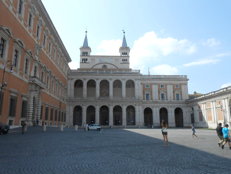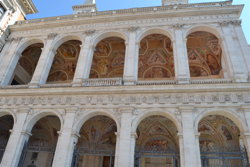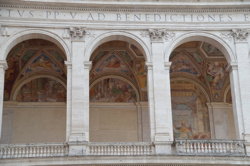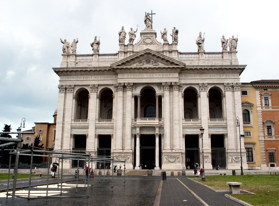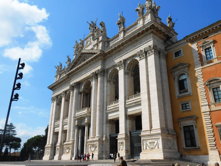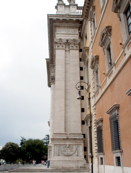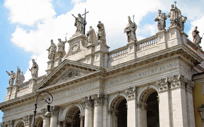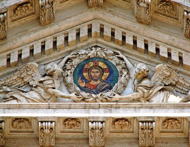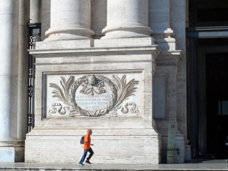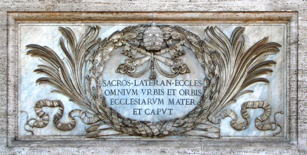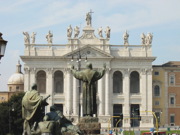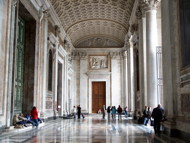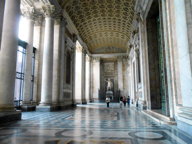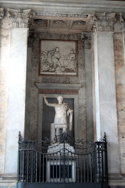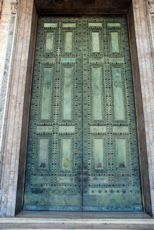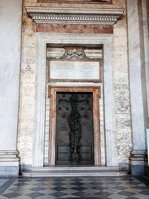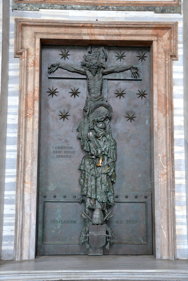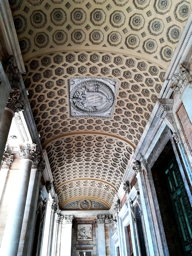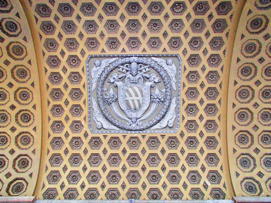Archbasilica of St. John Lateran is a heavily restored and remodelled 4th century basilica which is the cathedral of the Diocese of Rome.
For reference, a plan of the church is available
here.
On the façade, an inscription proclaims that this is SACROSANCTA LATERANENSIS ECCLESIA OMNIUM URBIS ET ORBIS ECCLESIARUM MATER ET CAPUT, "The Most Holy Lateran Church, Mother and Mistress of all churches of the city and the World". It is the first cathedral of Rome, where
Emperor Constantine allowed the Pope to set up the episcopal chair after 312. The first mention in ancient sources is from 313, when a consistory of bishops was held in domum Faustae in Laterano. This refers to
Fausta, Constantine's second wife, who was a convert. The Popes lived in the Lateran palace until
Clement V (1305-1314) transferred the papal seat to Avignon. After the return of the Pope to Rome in 1377, the Vatican palace was chosen as the papal residence.
The property belonged to the Laterani family, but when they fell from grace it was confiscated. Constantine gave it to the Church, and the church was built. It was first known as the Basilica Salvatoris, Basilica of the Saviour. The present name is a result of the importance of the baptistry in the church, and of the presence of a Benedictine monastery dedicated to Sts John the Baptist and John the Evangelist. At an early stage, it was also called the Basilica Aurea, the Golden Basilica, because of its rich decorations.
It was 90 meters long and 50-56 meters wide, and had five naves. The exterior was simple, but the interior was lavishly decorated.
The basilica was sacked by the
Vandals in the 5th century, and restored by
Pope St Gregory c. 460.
The first major restoration was ordered by
Pope Saint Sergius (687-701). It was restored again within a century, by
Pope Hadrian I (772-779).
In 897, the basilica was the scene of the "cadaver synod", when
Pope Stephen VI (896-897) had the body of
Pope Formosus (891-896) exhumed and put on a mock trial. The corpse was convicted and desecrated. During the synod, the basilica was ominously severely damaged by an earthquake.
Pope Sergius III (904-911) had the basilica completely rebuilt because of the earthquake damage. The old foundations were used, and it was built within the old perimeter. It was after this rebuilding that it was formally dedicated to St John the Baptist. The additional dedication to St John the Evangelist was made by
Pope Lucius II (1144-1145). An excellent fresco of the Medieval basilica can be seen in S Martino ai Monti.
On May 6th 1308, the basilica was totally destroyed by fire.
Pope Clement V (1305-1314) started rebuilding it, but it was destroyed by fire again in 1360.
Pope Urban V (1362-1370) commissioned Giovanni Stefano to rebuild it.
Pope Eugene IV (1431-1447) decided to rebuild parts of it.
In 1646, the basilica was in danger of collapsing.
Pope Innocent X gave the task of restoring it to
Borromini, in preparation for the Holy Year of 1650. It was during Borromini's restoration that the church was given its Baroque look; it no longer looks like an ancient basilica. Only the gilded ceiling and the Cosmatesque floor were kept; the former has since been restored and altered considerably. The dimensions were not changes much, the present church measuring 130 by 54 meters.
Some changes were made in 1884, when
Pope Leo XIII had the Vespignianis, father and son, extend the choir and move the apse mosaics. At around the same time, possibly from 1880, excavations were carried out which revealed remains of earlier buildings below the basilica.
Further excavations were carried out 1934-1938. It was revealed that the basilica was built on the foundations of the barracks of the equites singulares, part of Maxentius' army. This adds another factor to the choice of the site; by demolishing the barracks of his enemy and erecting a Christian basilica over the foundations, Constantine's victory was made even more complete.
